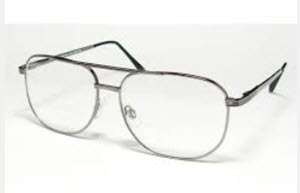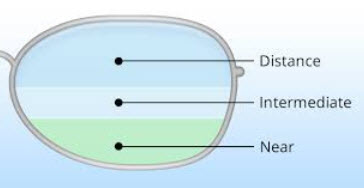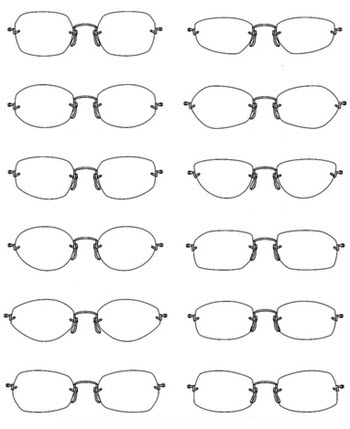Eyeglasses or spectacles, commonly referred to simply as glasses, are typically used for visual correction but can also be used to protect the eyes or simply for aesthetic reasons.
Corrective glasses can be used to correct the refractive errors that causes conditions such as myopia (nearsightedness), hyperopia (farsightedness / longsightedness) and astigmatism. Additionally, a lot of people over the age of 40 wear glasses to compensate for a loss of elasticity in the eye’s crystalline lens. This condition, known as presbyopia, reduces the lens’s ability to accommodate.
 Bifocal glasses
Bifocal glasses
A bifocal lens consists of two different areas with different visual correction. A very widespread version of bifocal glasses are the ones where the upper part of the lens is used when the wearer wants to look at objects far away, and the lower part of the lens is used when the wearer wants to look at something that is close. With this configuration, the lower part is called the add segment. Which size, shape and exact position of the add segment that is ideal will vary depending on wearer preferences.
The opposite of bifocal glasses are single vision glasses. With such glasses, the eyes need to accommodate for distance since there aren’t two different fields to chose between. If the eyes aren’t good at accommodating, the wearer might need to purchase two different glasses and switch between them. One pair for looking at objects far away (e.g. driving) and another pair for looking at something that is close (e.g. reading).
 Trifocal glasses
Trifocal glasses
In a pair of trifocal glasses, the two focal areas on the lens (described above) are separated by a third area and this area is for looking at objects that are located at roughly an arm’s length, e.g. a computer screen. Trifocal glasses thus contain one focal area for far away objects, one for arm’s length object and one for near objects.
Varifocal glasses (progressive glasses)
Varifocal glasses have lenses with progressive addition. This means that instead of two or more distinct fields, there is a smooth transition from one distance correction to another. Since there are no abrupt changes in correction, the lens looks more uniform.
Varifocal glasses are also known as progressive glasses.
The shape and size of the corrective lens
 Corrective lenses are available in many shapes and sizes. They are usually produced fairly big and round (a so called lens blank) by the lens manufacturer and then cut to fit the shape of the frame selected to hold them. The size and shape of glass frames isn’t just about practical consideration – fashion trends and personal preferences will also be important when a wearer selects a frame. Back in the days, when all eyeglasses were fairly utilitarian, virtually all lenses were round, oval or curved octagons.
Corrective lenses are available in many shapes and sizes. They are usually produced fairly big and round (a so called lens blank) by the lens manufacturer and then cut to fit the shape of the frame selected to hold them. The size and shape of glass frames isn’t just about practical consideration – fashion trends and personal preferences will also be important when a wearer selects a frame. Back in the days, when all eyeglasses were fairly utilitarian, virtually all lenses were round, oval or curved octagons.
Practical factors to consider when choosing frames:
- If the frames require two very big lenses, the glasses can become very heavy if the lenses are also high power lenses.
- Bifocal, trifocal and varifocal (progressive) glasses need to have lenses that are large enough to have room for the various corrections.
- With a small lens, the field of vision is also small. Sometimes this is a desirable effect, e.g. when a wearer wants to be able to momentarily look above their reading glasses to spot something in the distance rather than take them off.
- Vertex distance is the distance from the front of the eye to the back of the lens. Reducing the vertex distance can make it possible to reduce the size of the lens without losing field of view. Of course, there is a limit for how close to the eye it would be comfortable and practical to wear your glasses.If the power of the lens is more than 4 diopters, the vertex distance can impact the effective power.

